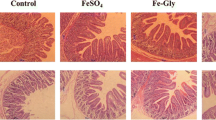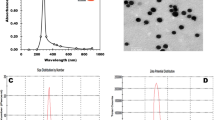Abstract
The current study was conducted with a mathematical model to investigate the appropriate iron supplementation by analyzing growth performance, hematological parameters, nutrient utilization, organ development, and Fe-containing enzyme activity in Pekin ducks. A total of 1120 ducks (1-day-old; 50.62 ± 0.20 g) were randomly allotted to seven groups with eight replicates of 20 ducks per replicate. Ducks were fed either a low-iron diet or basal diets supplemented with 0, 30, 60, 90, 120, and 150 mg Fe/kg from iron sulfate, respectively. The results showed that iron deficiency decreased body weight (BW), average daily gain (ADG), average daily feed intake (ADFI), red blood cell count (RBC), hemoglobin (Hb), hematocrit (Hct), mean cell volume (MCV), the apparent utilization of energy and dry matter, the weight of duodenum, jejunum, and ileum but increased feed conversion ratio (F/G) (P < 0.05). Meanwhile, birds in low-iron groups showed an increase in oxidative stress evidenced by the decreased catalase (CAT) activities and production of malonaldehyde (MDA) (P < 0.05). On the contrary, diets supplemented with iron significantly improved the growth performance, in different ages, and achieved the best values in group 4 which supplemented 60 mg Fe/kg (P < 0.05). Also, iron supplementation increased the apparent utilization of energy and dry matter but decreased the utilization of iron in ducks at 35 days of age (P < 0.05). Furthermore, the hematological and intestine Fe-containing enzyme activities were improved with iron up to an optimal level (P < 0.05) at 14 and 35 days. In conclusion, iron deficiency impaired growth performance, physiological indexes, nutrient utilization, and antioxidant system, while dietary 71.25~82.80 mg/kg iron for starter ducks and 75.00~89.41 mg/kg iron for grower ducks were suggested to improve growth performance.

Similar content being viewed by others
References
Li XF, Zhang LY, Zhang LY, Lu L, Luo XG (2017) Effect of iron source on iron absorption by in situ ligated intestinal loops of broilers. Anim Prod Sci 57:308–314
Davis PN, Norris LC, Kratzer FH (1968) Iron utilization and metabolism in the chick. J Nutr 94:407–417
Elvehjem CA, Hart EB, Kemmerer WOAR (1929) The relation of iron and copper to hemoglobin synthesis in chick. J Biol Chem 84:131–141
Jamroz D, Wiliczkiewicz A, Orda J, Wertelecki T, Skorupińska J (2002) Aspects of development of digestive activity of intestine in young chickens, ducks and geese. J Anim Physiol Anim Nutr 86:353–366
Storey ML, Allen NK (1982) The effect of fasting time of mature, nonlaying female embden geese on true metabolizable energy of corn. Poult Sci 61:101–106
Kong C, Adeola O (2013) Comparative amino acid digestibility for broiler chickens and White Pekin ducks. Poult Sci 92:2367–2374
Sorapukdee S, Narunatsopanon S (2017) Comparative study on compositions and functional properties of porcine, chicken and duck blood. Korean J Food Sci Anim Resour 37:228–241
Braine A (2012) Update on the duck market in 2011-2012. TeMA Techniques et Marchés Avicoles:15–19
Sun J, Liu D, Shi RB (2015) Supplemental dietary iron glycine modifies growth, immune function, and antioxidant enzyme activities in broiler chickens. Livest Sci 176:129–134
AOAC (1995) Official methods of analysis, 16th edn. Association of Official Analytical Chemists, Arlington
Bai SP, Huang L, Luo YH, Wang LL, Ding XM, Wang JP, Zeng QF, Zhang KY (2014) Dietary manganese supplementation influences the expression of transporters involved in iron metabolism in chickens. Biol Trace Elem Res 160:352–360
Zhu C, Lv H, Chen Z, Wang L, Wu XJ, Chen ZJ, Zhang WN, Liang R, Jang ZY (2016) Dietary zinc oxide modulates antioxidant capacity, small intestine development, and jejunal gene expression in weaned piglets. Biol Trace Elem Res 175:1–8
Taschetto D, Vieira SL, Angel CR, Stefanello C, Kindlein L, Ebbing MA, Simoes CT (2017) Iron requirements of broiler breeder hens. Poult Sci 96:3920–3927
Tako E, Rutzke MA, Glahn RP (2010) Using the domestic chicken (Gallus gallus) as an in vivo model for iron bioavailability. Poult Sci 89:514–521
Rothenbacher H, Sherman AR (1980) Target organ pathology in iron-deficient suckling rats. J Nutr 110:1648–1654
Kochanowski BA, Sherman AR (1985) Decreased antibody formation in iron-deficient rat pups—effect of iron repletion. Am J Clin Nutr 41:278–284
Davis PN, Norris LC, Kratzer FH (1962) Iron deficiency studies in chicks using treated isolated soybean protein diets. J Nutr 78:445–453
Chen S, Shirazi M, Orr RA (1983) Triiodothyronine (T3) and thyroxine (T4) levels in iron-deficient, hypertriglyceridemic rats. Nutr Res 3:91–106
Dillman E, Gale C, Green W, Johnson DG, Mackler B, Finch C (1980) Hypothermia in iron deficiency due to altered triiodothyronine metabolism. Am J Phys 239:377–381
Vahl HA, Klooster ATVT (1987) Dietary iron and broiler performance. Br Poult Sci 28:567–576
Abbasi M, Zaghari M, Khalaji MG, Ganjkhanlo M, Khalaji S (2015) Is dietary iron requirement of broiler breeder hens at the late stage of production cycle influenced by phytase supplementation? J Appl Anim Res 43:166–176
Shi R, Liu D, Sun J, Jia Y, Zhang P (2015) Effect of replacing dietary FeSO4 with equal Fe-levelled iron glycine chelate on broiler chickens. Czech J Anim Sci 60:233–239
Wang J, Li DS, Che LQ, Fang ZF, Xu SY, Wu D (2014) Influence of organic iron complex on sow reproductive performance and iron status of nursing pigs. Livest Sci 160:89–96
Amine EK, Neff R, Hegsted DM (1972) Biological estimation of available iron using chicks or rats. J Agric Food Chem 20:246–251
Kwiecień M, Samolińska W, Bujanowicz-Haraś B (2015) Effects of iron–glycine chelate on growth, carcass characteristic, liver mineral concentrations and haematological and biochemical blood parameters in broilers. J Anim Physiol Anim Nutr 99:1184–1196
Ma XY, Liu SB, Lu L, Li SF, Xie JJ, Zhang LY, Zhang JH, Luo XG (2014) Relative bioavailability of iron proteinate for broilers fed a casein-dextrose diet. Poult Sci 93:556–563
Shinde PL, Ingale SL, Choi JY, Kim JS, Pak SI, Chae BJ (2011) Efficiency of inorganic and organic iron sources under iron depleted conditions in broilers. Br Poult Sci 52:578–583
Florou-Paneri P (2015) Effect of dietary iron sulfate and iron chelate on growth performance, hematological traits, intestinal microbial flora of fattening pigs and quality parameters of porkmeat. J Vet Sci 3:11–22
Mondal S, Haldar S, Saha P, Ghosh TK (2010) Metabolism and tissue distribution of trace elements in broiler chickens' fed diets containing deficient and plethoric levels of copper, manganese, and zinc. Biol Trace Elem Res 137:190–205
Oduguwa OO, Oduguwa BO, Fanimo AO, Dipeolu MA (2000) Potency of two proprietary micronutrient premixes for broiler chickens at marginally deficient protein contents. Arch Zootec 49:433–444
Wen M, Zhao H, Liu GM, Chen XL, Wu B, Tian G, Cai JY, Jia G (2017) Effect of zinc supplementation on growth performance, intestinal development, and intestinal barrier-related gene expression in Pekin ducks. Biol Trace Elem Res 2:351–360
Liu HH, Wang JW, Zhang RP, Chen X, Yu HY, Jin HB, Li LL, Han CC, Xu F, Kang B, He H, Xu HY (2012) In ovo feeding of IGF-1 to ducks influences neonatal skeletal muscle hypertrophy and muscle mass growth upon satellite cell activation. J Cell Physiol 227:1465–1475
Sáiz MP, Martí MT, Mitjavila MT, Planas J (1993) Iron absorption by small intestine of chickens. Biol Trace Elem Res 36:7–14
Nicholls DG, Budd SL (2000) Mitochondria and neuronal survival. Physiol Rev 80:315–360
Zödl B, Zeiner M, Marktl W, Steffan I, Ekmekcioglu C (2003) Pharmacological levels of copper exert toxic effects in Caco-2 cells. Biol Trace Elem Res 96:143–152
Pondarré C, Antiochos BB, Campagna DR, Clarke SL, Greer EL, Deck KM, Mcdonald A, Han AP, Medlock A, Anderson JLKSA, Eisenstein RS, Fleming MD (2006) The mitochondrial ATP-binding cassette transporter Abcb7 is essential in mice and participates in cytosolic iron-sulfur cluster biogenesis. Hum Mol Genet 15:953–964
Qiao YG, Tan BP, Mai KS, QH A, Zhang WB, Xu W (2013) Evaluation of iron methionine and iron sulphate as dietary iron sources for juvenile cobia (Rachycentron canadum). Aquac Nutr 19:721–730
Srigiridhar K, Nair KM (1998) Iron-deficient intestine is more susceptible to peroxidative damage during iron supplementation in rats. Free Radic Biol Med 25:660–665
Bacon BR, Tavill AS, Brittenham GM, Park CH, Recknagel RO (1983) Hepatic lipid peroxidation in vivo in rats with chronic iron overload. J Clin Invest 71:429–439
Feng J, Ma WQ, Xu ZR, He JX, Wang YZ, Liu JX (2009) The effect of iron glycine chelate on tissue mineral levels, fecal mineral concentration, and liver antioxidant enzyme activity in weanling pigs. Anim Feed Sci Technol 150:106–113
Zhang L, Feng L, Jiang WD, Liu Y, Jiag J, Li SH, Kuang TSY, Zhou XQ (2016) The impaired flesh quality by iron deficiency and excess is associated with increasing oxidative damage and decreasing antioxidant capacity in the muscle of young grass carp (Ctenopharyngodon idellus). Aquac Nutr 22:191–201
Acknowledgments
The present study was financial supported by the Science and Technology Support Program of Sichuan Province (Grant No. 2013NZ0054) and the research funding was also provided by Sichuan Longda Animal Husbandry Science and Technology Co., Ltd. (No. 009H2200).
Author information
Authors and Affiliations
Corresponding author
Rights and permissions
About this article
Cite this article
Xie, D., Wen, M., Wu, B. et al. Effect of Iron Supplementation on Growth Performance, Hematological Parameters, Nutrient Utilization, Organ Development, and Fe-Containing Enzyme Activity in Pekin Ducks. Biol Trace Elem Res 189, 538–547 (2019). https://doi.org/10.1007/s12011-018-1488-6
Received:
Accepted:
Published:
Issue Date:
DOI: https://doi.org/10.1007/s12011-018-1488-6




